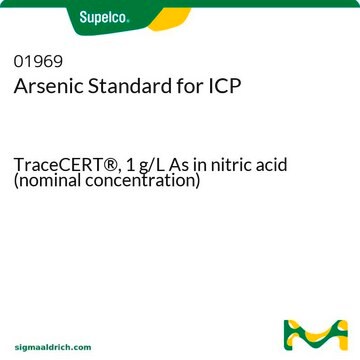1.70303
Arsenic ICP standard
traceable to SRM from NIST H₃AsO₄ in HNO₃ 2-3% 1000 mg/l As Certipur®
Synonym(s):
Arsenic Calibration Standard for ICP/AAS
About This Item
Recommended Products
grade
certified reference material
Quality Level
Agency
suitable for EPA 200.7
suitable for EPA 200.8
product line
Certipur®
technique(s)
ICP: suitable
pH
0.5 (20 °C in H2O)
density
1.013 g/cm3 at 20 °C
application(s)
industrial qc
pharmaceutical
format
single component solution
storage temp.
15-25°C
General description
Please visit ISO certificates and Site Quality Self-Assessments to access the current certificates of accreditation.
Download your certificate at http://www.sigma-aldrich.com to view certified values, including uncertainty, date of expiry, and detailed information about trace impurities.
Application
Analysis Note
Other Notes
Legal Information
Signal Word
Danger
Hazard Statements
Precautionary Statements
Hazard Classifications
Carc. 1B - Eye Irrit. 2 - Met. Corr. 1 - Skin Irrit. 2
Storage Class Code
6.1D - Non-combustible acute toxic Cat.3 / toxic hazardous materials or hazardous materials causing chronic effects
WGK
WGK 3
Flash Point(F)
Not applicable
Flash Point(C)
Not applicable
Certificates of Analysis (COA)
Search for Certificates of Analysis (COA) by entering the products Lot/Batch Number. Lot and Batch Numbers can be found on a product’s label following the words ‘Lot’ or ‘Batch’.
Already Own This Product?
Find documentation for the products that you have recently purchased in the Document Library.
Customers Also Viewed
Articles
A 4-step comprehensive ICP-MS workflow including sample homogenization, with standard addition calibration method, to determine heavy metals in Cannabis sativa.
A 4-step comprehensive ICP-MS workflow including sample homogenization, with standard addition calibration method, to determine heavy metals in Cannabis sativa.
A 4-step comprehensive ICP-MS workflow including sample homogenization, with standard addition calibration method, to determine heavy metals in Cannabis sativa.
A 4-step comprehensive ICP-MS workflow including sample homogenization, with standard addition calibration method, to determine heavy metals in Cannabis sativa.
Related Content
This page is intended to make it easier to find the consumables you need based on the analytical method you’re using. Methods included on this page come from the EPA, Standard Methods and ASTM.
This page is intended to make it easier to find the consumables you need based on the analytical method you’re using. Methods included on this page come from the EPA, Standard Methods and ASTM.
This page is intended to make it easier to find the consumables you need based on the analytical method you’re using. Methods included on this page come from the EPA, Standard Methods and ASTM.
This page is intended to make it easier to find the consumables you need based on the analytical method you’re using. Methods included on this page come from the EPA, Standard Methods and ASTM.
Our team of scientists has experience in all areas of research including Life Science, Material Science, Chemical Synthesis, Chromatography, Analytical and many others.
Contact Technical Service









